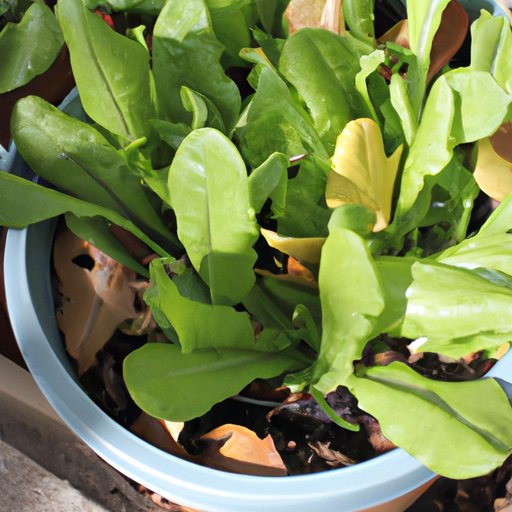
I. Introduction
Do you love salads or simply want to explore the world of gardening? Lettuce is a great place to start. Growing lettuce is easy, rewarding, and doesn’t require a lot of space. In this article, we will provide a comprehensive guide to help you grow your own lettuce, whether you’re a beginner or an experienced gardener.
II. A Step-by-Step Guide to Growing Lettuce
Before you start planting, it’s important to understand the different types of lettuce. There are many varieties of lettuce, such as Romaine, Bibb, Iceberg, and Looseleaf. Choose the best variety for your needs based on flavor, texture, and growth habits. For instance, if you want crisp lettuce, you might opt for Romaine lettuce. If you prefer a sweeter taste, you might like the tender leaves of looseleaf lettuce.
After deciding on the type of lettuce, the next step is to prepare your soil. You should clean the soil of any weeds or rocks, loosen it by digging deeply with a garden fork, and enrich it with organic matter such as compost or well-rotted manure. Lettuce prefers fertile, well-draining soil with a pH range of 6.0 to 7.0.
Now that the soil is ready, you can start planting your lettuce. Plant the seeds shallowly, just about 1/8 inch deep, and water gently. Plant them about 6-12 inches apart to give them enough space to grow. It’s important to keep the soil consistently moist so that it doesn’t dry out. Once the seedlings grow a few inches tall and develop a true leaf, thin out each seedling to grow at least 4-6 inches apart.
As the plants grow, keep watering them regularly. Lettuce needs about an inch of water per week. Fertilize every 3-4 weeks with a nitrogen-rich fertilizer to boost growth. Keep an eye out for pests such as aphids or slugs, which can damage the lettuce leaves. If you spot any pests, remove them manually or use organic insecticidal soap to eliminate them.
After about six weeks, your lettuce will be ready for harvest. Use a pair of sharp scissors to cut the leaves rather than pulling them from the plant to avoid damaging the plant roots.
III. Tips for a Successful Harvest
The key to harvesting healthy and delicious lettuce is maintaining the right growing conditions. Here are some tips to help:
- Water the plants early in the day so that the leaves have enough time to dry before nightfall. This can help prevent diseases.
- Apply mulch around the base of the plants to suppress weed growth and keep soil moisture levels consistent.
- Prune the leaves of the lettuce regularly to promote growth and avoid overcrowding.
- Use natural pest control methods such as companion planting or organic insecticides to keep pests at bay.
IV. Container Gardening
If you don’t have a lot of space or want to grow lettuce indoors, container gardening is a great option. You can use a variety of containers, such as planters, pots, or window boxes, as long as they are deep enough to support the roots and have proper drainage.
When choosing a container, consider the size of the plants and how much room they will need to grow. In addition, make sure to choose a potting soil that is well-draining and enriched with nutrients. Water the plants regularly and fertilize every 3-4 weeks.
Harvesting lettuce from containers is easy. Simply cut the leaves with sharp scissors when they are mature enough to eat.
V. Best Varieties for Every Season
While lettuce can be grown throughout the year, certain varieties thrive in specific seasons and climates. Here are some popular varieties for each season:
- Spring: Buttercrunch, Oakleaf, Romaine, Spinach
- Summer: Arugula, Red Sails, Summer Bibb, Looseleaf
- Fall: Mache, Radicchio, Red Oakleaf, Endive
- Winter: Winter Density, Rouge d’Hiver, Little Gem
To find the best time to plant, consult your local gardening center or extension office. They can provide guidance on when to plant based on your specific location.
VI. Sustainable Gardening Practices
When growing lettuce, it’s important to practice sustainable gardening methods. Here are some tips:
- Use compost or other organic matter to enrich your soil and decrease the need for synthetic fertilizers.
- Limit your use of pesticides and instead use natural pest control methods such as companion planting, handpicking, or insecticidal soap.
- Plant lettuce close to other crops that promote soil health and attract beneficial insects, such as marigolds or basil.
- Harvest rainwater to use for watering instead of relying on tap water.
VII. Conclusion
Growing your own lettuce is a great way to save money, eat healthy, and connect with nature. By following these steps, you can easily grow your own lettuce from seed to harvest. Be sure to choose the variety that best suits your needs and try container gardening if you have limited space. Practice sustainable gardening methods to create a healthy and thriving ecosystem.




